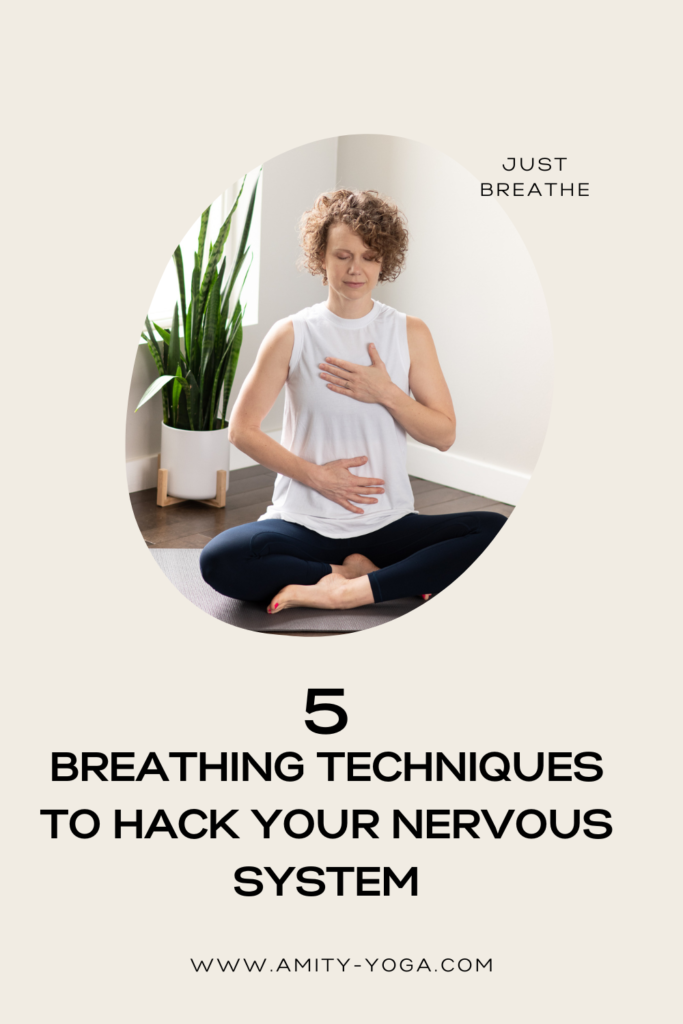
Just Breathe
Don’t Overlook the Mighty Power of the Breath
The breath often gets overlooked and underrated – but it’s the ultimate tool for slowing down, tuning in, and shifting moods. Just by making subtle changes to the way we breathe – altering the cadence, interval, rhythm, using the nostrils vs mouth – can have huge impacts on our physical, mental, and emotional well-being. And ANYONE has the power to access this mighty tool! After all, it is that simple: JUST BREATHE. Let’s explore five breath techniques that have the ability to shift our mood, reduce stress and anxiety, calm our nerves, and hone our focus. Each of these techniques can be performed anywhere, require no extra props, and only take a couple of minutes out of your busy schedule.
Why control the breath?
Breathing is pretty simple, right? Most often, we don’t even have to think about this involuntary act – we simply inhale/exhale as needed. But what’s so interesting about the breath is that it is both involuntary and voluntary – meaning we have the ability to control the cadence, interval, rhythm, and point through which we breathe (nostrils vs mouth).
But why would we want to control the breath? Let me count the ways!!
Consider this. Ancient yogis believed that each person was born with a specific number of breaths to take in their lifetime. Once they reached this predetermined number of breaths, you guessed it, their life was over. Which is one reason why yogis have been practicing pranayama, or breathing techniques, for thousands of years. By exercising their ability to regulate and elongate their inhales and exhales, as well as the pauses in between the breaths, yogis have essentially been elongating their very lives. More time with loved ones, anyone? I’m in!!
But creating these long, full, deep inhales and exhales with spacious pauses between them not only has the power to elongate our lives, according to these ancient yogis, but they also believed that creating space between our breaths allows us to create space between our thoughts. So to rise above our stress, we must rise above our thoughts, and to do this, we can create space between our breath. Not tapping into this simple practice would mean limiting the breath and therefor, limiting the mind.
Think about it – most of us carry on day-in and day-out with little awareness of the breath. We cope with daily stressors in various ways, usually with little to no attention to our breath. But if we pause for a moment in stressful situations and bring our awareness to the breath, we might notice that our stress has caused shallow breathing – and wouldn’t you know it, shallow breathing usually causes stress! We’re actually compounding the problem and we didn’t even know it!
But don’t worry! We can use five simple breathing techniques in any situation to help us cope with daily stressors, allowing us to shift our mood, reduce stress and anxiety, calm our nerves, or even hone our focus.
Breath + The Nervous System
To understand how these techniques affect our nervous system, let’s break things down for a moment.
First, let’s address the sympathetic nervous system, here defined by the Cleveland Clinic:
Your sympathetic nervous system is a network of nerves that helps your body activate its “fight-or-flight” response. This system’s activity increases when you’re stressed, in danger or physically active. Its effects include increasing your heart rate and breathing ability, improving your eyesight and slowing down processes like digestion.
Cleveland Clinic; https://my.clevelandclinic.org/health/body/23262-sympathetic-nervous-system-sns-fight-or-flight
So – your sympathetic nervous system supports your body by protecting you in stressful or dangerous situations. It has the ability to give us superhuman powers when we most need them – maybe you’ve seen one of those viral YouTube videos of someone single-handedly lifting a car up to save someone lying underneath it – someone who normally would hardly have the ability to lift one tire on their own. Cool, right? Well, yes, it is. The sympathetic system controls the release of various hormones, increases our heart rate, and makes other alterations to our bodily functions, that all support these superhuman actions with the ultimate goal of protecting ourselves or others. The problem is, the sympathetic nervous system is something that should only be activated on an as-needed basis. Unfortunately, most of us are living in a constant state of ‘orange alert’ due to different stressors in our life. This means your sympathetic nervous system is working overtime – and you guess it – it’s still releasing hormones, increasing your heart rate, and altering other bodily functions on more of a long-term basis . . . causing damage all the while. But no fear (get it?!), you have the power to harness the breath to activate your parasympathetic nervous system and bring your body to a regulated and relaxed state.
The parasympathetic nervous system as defined by the Cleveland Clinic:
Your parasympathetic nervous system is a network of nerves that relaxes your body after periods of stress or danger. It also helps run life-sustaining processes, like digestion, during times when you feel safe and relaxed.
Cleveland Clinic; https://my.clevelandclinic.org/health/body/23266-parasympathetic-nervous-system-psns
You see? There’s hope after all! Your parasympathetic nervous system is here to the rescue! It has the ability to bring you into a relaxed, restful state – returning your body to it’s regular functions, and allowing you to operate more efficiently. Activating this system means responding more calmly to stimuli (aka, not flying-off-the handle or flipping your lid) and having the ability to use your full cognitive function (aka – you can think more clearly/gain perspective).
So if you’ve been stuck in this constant state of stress or ‘orange alert,’ how do you activate the parasympathetic nervous system? Simple: JUST BREATHE. You can use your breath to trigger the parasympathetic nervous system, bringing your body and it’s physiological responses back to a calm and regulated state.
Here’s where our breathing techniques come in. As you practice each one, think about adjusting the breath like adjusting the thermostat in your home. When you change the cadence, interval, entry/exit point (nostril vs mouth), and rhythm, you are adjusting the ‘temperature’ of the body, just like when you turn the thermostat in your home up or down. So no matter what you feel, you can pull out a breathing technique to make adjustments in your body!
Let’s try it out!
5 Breathing Techniques
Use any of these breathing techniques when you feel stressed or overwhelmed. Simply find a comfortable position, even if it’s sitting in your parked car, locking yourself in a bathroom stall, or standing outside under a shade tree. No matter where you find yourself, spend a few minutes breathing and notice the difference it create in your body.
Keep Breathing
After giving each breathing technique a try, hopefully you’ve found one (or more) that works for you. Stop living in a state of ‘orange alert’ where your sympathetic nervous system is taxing your body, and start consciously breathing to hack into the parasympathetic nervous system and activate a calmer state of being where you can function effectively and efficiently.
Whether you’re in your office, on an airplane, standing in line at the grocery store – it doesn’t matter – you can hack into the parasympathetic nervous system and reap the calming benefits of the breath – it really is that simple!!

